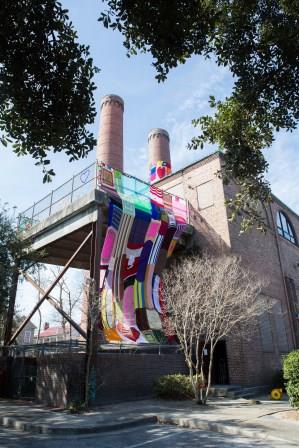For two months last winter, residents gathered at Charleston’s St. Julian Devine Community Center on Monday nights and knitted colorful squares which would eventually be pieced together into a giant, 40-foot flag. In February, the group hung their work on the old brick Cigar Factory behind the community center as a way to draw attention to the center and its programs.

St. Julian Devine Community Center officially "love bombed" (with knitted yarn) in Charleston
The "Love Bomb" is part of an effort by local nonprofit Enough Pie to catalyze community engagement through creativity, according to Executive Director Cathryn Zommer. Enough Pie uses partnerships, artistic collaborations and placemaking to inspire inclusivity and community involvement in Charleston’s Upper Peninsula.
"You can ignite a Main Street with placemaking," Zommer said. "It’s a great way to revitalize underutilized places."
Placemaking is the concept of helping people create and sustain public spaces that build stronger communities. An effective placemaking process centers on community-based participation, and then focuses on that community’s assets, inspiration and potential to create quality public spaces that contribute to people’s health, happiness and well-being, according to the Project for Public Spaces.
Too often, cities have been designed around cars. Placemaking focuses on the importance of the human experience—walkable areas, lively neighborhoods and inviting public spaces.
Certain cities around the country seem to be a magnet for talented young professionals. It’s not because of their taxes or regulations but, very simply, because of their "place," according to Dan Gilmartin, executive director and CEO of the Michigan Municipal League, and a national leader in the field of placemaking. These cities are the kinds of places that attract a young, well-educated, talented workforce.
Gilmartin said these young professionals are looking for 21st century communities that put a focus on 1) physical design and walkability, 2) green initiatives, 3) cultural economic development, 4) entrepreneurship, 5) multiculturalism, 6) technology, 7) transit and 8) education.
"If I’m a city leader, I need to understand what people are looking for," Gilmartin said. "You’ve got to provide it or go forward at your own peril."
Placemaking starts with an inclusive, bottom-up approach, often driven by individuals who want to make a change or impact on their community. The city then needs to create the platform for that change to occur, Gilmartin said. Historic districts, for example, are often created when one entrepreneur or a group decides to come in and make changes. The city would need to facilitate those changes to spur economic growth.
Civic engagement is an important piece of placemaking. Elected officials need to realize that they need to engage people differently. Gilmartin said there are many people who want to be involved in civic life, but they’re not going to meetings at city hall.

Coffee with the Mayor is part of Mount Pleasant’s extensive outreach strategy
to "take the town out of town hall" and engage residents where they already are.
"You’ve got to meet people where they are, get out of your comfort zone," Gilmartin said. "There are so many ways to get hold of folks and get them engaged in the community, but you cannot go through the same old channels."
Placemaking should be the result of a holistic approach to community design, according to Randy Wilson, president of Community Design Solutions and frequent resource team member for Main Street South Carolina.
Placemaking efforts should be authentic to a place, Wilson said. For instance, a community cannot simply import something done by another town. Rather, city leaders should look at what other towns do and consider how to shape those ideas to meet their community’s own unique needs and features.
Not everything has to be expensive; sometimes a simple approach is better. Wilson said he worked with the city of Pascagoula, Mississippi. The city was struggling to address its issues with a small urban core consisting of a Main Street only two to three blocks long. Overpriced buildings made it hard for business owners to buy or rent property.
The town repurposed Mississippi cottages—emergency housing put in place after Hurricane Katrina—into a small business incubator section downtown. The addition of the cottages extended the Main Street area and provided affordable rentals for small start-up businesses, Wilson said. The cottages were arranged around a boardwalk and town green. The area has evolved into a festival and event location, he added.
Effective placemaking is complemented by regular programming, Wilson said. It’s not enough to create a place, he continued, there also needs to be a plan in place about what will go in it. Variety also is important. One public space might find use as a dog park, another as a gathering spot for festivals. Public input is key in determining the needs and desires of the neighboring community. Through the collaborative process of placemaking, city leaders can shape public spaces to maximize shared value.
Great places start with people coming together to share a vision of what the place can be, said Zommer of Charleston. It’s ok to experiment with an idea, to fail and to modify plans, she said. By creating more public places where people can come together, communities become better connected.
"We all have a hand in making places great," Zommer said.
During the Association’s Annual Meeting in July, there will be a half-day preconference session on the topic of placemaking.
